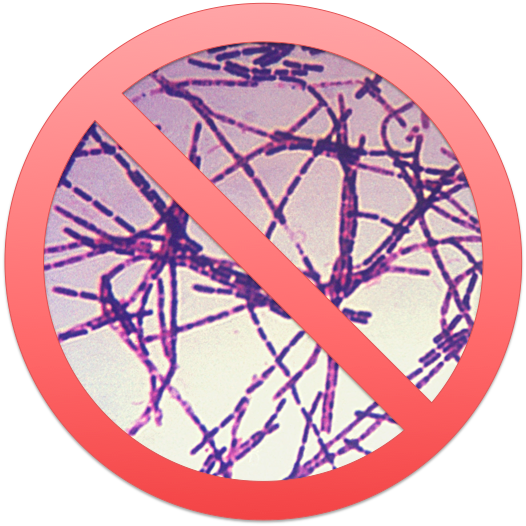Team:Washington/Project/Safety/Anthrax
From 2010.igem.org
| Line 25: | Line 25: | ||
</html> | </html> | ||
<!---------------------------------------PAGE CONTENT GOES BELOW THIS----------------------------------------> | <!---------------------------------------PAGE CONTENT GOES BELOW THIS----------------------------------------> | ||
| - | [[Image:Crossed_out_anthrax.jpg| | + | [[Image:Crossed_out_anthrax.jpg|140px|right]] |
We did not handle, culture, transport, or otherwise come into contact with Bacillus anthracis or derivatives created or purified from live Bacillus anthracis nor did we plan to. Our Gram-positive treatment utilizes the protein CapD, which is natively produced by Anthrax to anchor a Poly-D-γ-glutamate layer to its extracellular matrix. CapD is a gene that Bacillus anthracis uses to create its home, and unrelated to factors that Bacillus anthracis uses to kill hosts. We created our CapD plasmid from oligo synthesis, thus avoiding Bacillus anthracis. CapD is non-toxic and its catalytic properties, transpeptidation and hydrolysis of Poly-D-γ-glutamate, are not dangerous to humans, nor could CapD be mutated to create a protein that would be dangerous to humans. The amino acid sequence and structure of CapD is already in the public domain and its addition to the registry presents no danger to the public. | We did not handle, culture, transport, or otherwise come into contact with Bacillus anthracis or derivatives created or purified from live Bacillus anthracis nor did we plan to. Our Gram-positive treatment utilizes the protein CapD, which is natively produced by Anthrax to anchor a Poly-D-γ-glutamate layer to its extracellular matrix. CapD is a gene that Bacillus anthracis uses to create its home, and unrelated to factors that Bacillus anthracis uses to kill hosts. We created our CapD plasmid from oligo synthesis, thus avoiding Bacillus anthracis. CapD is non-toxic and its catalytic properties, transpeptidation and hydrolysis of Poly-D-γ-glutamate, are not dangerous to humans, nor could CapD be mutated to create a protein that would be dangerous to humans. The amino acid sequence and structure of CapD is already in the public domain and its addition to the registry presents no danger to the public. | ||
Revision as of 18:53, 2 September 2010
We did not handle, culture, transport, or otherwise come into contact with Bacillus anthracis or derivatives created or purified from live Bacillus anthracis nor did we plan to. Our Gram-positive treatment utilizes the protein CapD, which is natively produced by Anthrax to anchor a Poly-D-γ-glutamate layer to its extracellular matrix. CapD is a gene that Bacillus anthracis uses to create its home, and unrelated to factors that Bacillus anthracis uses to kill hosts. We created our CapD plasmid from oligo synthesis, thus avoiding Bacillus anthracis. CapD is non-toxic and its catalytic properties, transpeptidation and hydrolysis of Poly-D-γ-glutamate, are not dangerous to humans, nor could CapD be mutated to create a protein that would be dangerous to humans. The amino acid sequence and structure of CapD is already in the public domain and its addition to the registry presents no danger to the public.
 "
"

